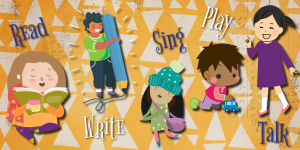
The Itsy Bitsy Spider not only goes up and down the water spout, but that sunshine-loving arachnid also teaches little fingers to get ready for writing. Who knew?
We may think of our simple songs and fingerplays as entertainment, a fun way to spend time with our little learner. But by making shapes and movements with our fingers, hands and wrists, we are preparing for the muscle control and coordination that will help build good penmanship, or, in these days, strong keyboard skills.
Some fingerplays include repetition and practice of finger isolation, while others encourage larger motor planning skills and bilateral coordination movements, early literacy experts say.
These actions help develop hand and finger strength and coordination -- necessary for a child to correctly hold and control a pencil when drawing and writing at school -- and encourage body awareness, finger awareness, coordination of hand or foot movement, hand-eye coordination and foot-eye coordination.
For Babies
Babies love hand and finger rhymes where parents actively do the movements with and on their body parts – tickling their skin, wriggling their fingers and toes.
For Toddlers
Children become aware of their hands and feet before they are aware of their fingers and toes. So, with toddlers, first do songs and rhymes which involve the movement of the hands and feet as a whole, such as clapping hands together, shaking hands, rolling hands around each other and using them to tap on other body parts, like their knees, or tummy. Feet can be stamped, wriggled, and tapped by hands.
For Preschoolers
Begin to introduce “tall man” and “ring man.” Three-year-olds will begin to manage individual finger games and by the time a child is four years old they will clamor to do the fingerplays they love. With practice, most can competently manage a range of simple fingerplays and action rhymes.
-Jeannie, Children's Team at Sahuarita Library
 Read, Write, Talk, Sing, Play!
Read, Write, Talk, Sing, Play!
When children are given a chance to explore scribbling, draw pictures, and tell stories, they are learning reading skills. Being an active participant in writing helps keep children excited about reading stories.
Read more about early literacy and how you can make a difference in your child's life.

